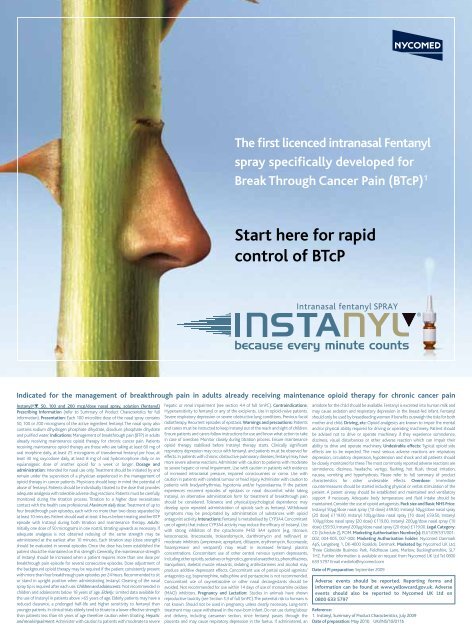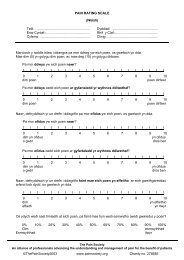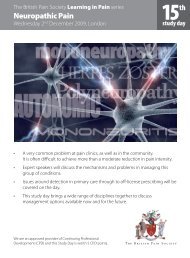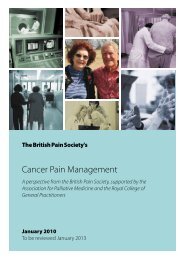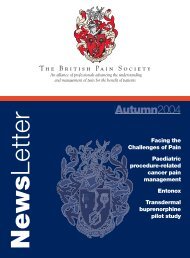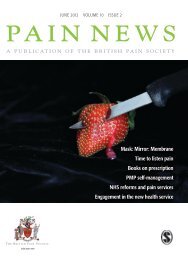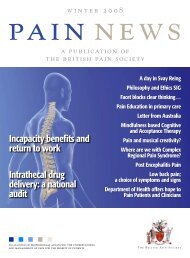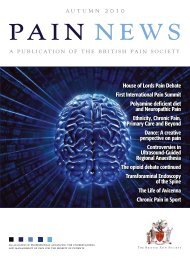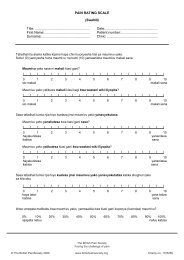Summer 2010 - The British Pain Society
Summer 2010 - The British Pain Society
Summer 2010 - The British Pain Society
You also want an ePaper? Increase the reach of your titles
YUMPU automatically turns print PDFs into web optimized ePapers that Google loves.
<strong>The</strong> first licenced intranasal Fentanyl<br />
spray specifically developed for<br />
Break Through Cancer <strong>Pain</strong> (BTcP) 1<br />
Start here for rapid<br />
control of BTcP<br />
Indicated for the management of breakthrough pain in adults already receiving maintenance opioid therapy for chronic cancer pain<br />
Instanyl®▼ 50, 100 and 200 mcg/dose nasal spray, solution (fentanyl)<br />
Prescribing Information (refer to Summary of Product Characteristics for full<br />
information). Presentation: Each 100 microlitre dose of the nasal spray contains<br />
50, 100 or 200 micrograms of the active ingredient fentanyl. <strong>The</strong> nasal spray also<br />
contains sodium dihydrogen phosphate dihydrate, disodium phosphate dihydrate<br />
and purified water. Indications: Management of breakthrough pain (BTP) in adults<br />
already receiving maintenance opioid therapy for chronic cancer pain. Patients<br />
receiving maintenance opioid therapy are those who are taking at least 60 mg of<br />
oral morphine daily, at least 25 micrograms of transdermal fentanyl per hour, at<br />
least 30 mg oxycodone daily, at least 8 mg of oral hydromorphone daily or an<br />
equianalgesic dose of another opioid for a week or longer. Dosage and<br />
administration: Intended for nasal use only. Treatment should be initiated by and<br />
remain under the supervision of a physician experienced in the management of<br />
opioid therapy in cancer patients. Physicians should keep in mind the potential of<br />
abuse of fentanyl. Patients should be individually titrated to the dose that provides<br />
adequate analgesia with tolerable adverse drug reactions. Patients must be carefully<br />
monitored during the titration process. Titration to a higher dose necessitates<br />
contact with the health care professional. Maximum daily dose: Treatment of up to<br />
four breakthrough pain episodes, each with no more than two doses separated by<br />
at least 10 minutes. Patient should wait at least 4 hours before treating another BTP<br />
episode with Instanyl during both titration and maintenance therapy. Adults:<br />
Initially one dose of 50 micrograms in one nostril, titrating upwards as necessary. If<br />
adequate analgesia is not obtained redosing of the same strength may be<br />
administered at the earliest after 10 minutes. Each titration step (dose strength)<br />
should be evaluated in several episodes. Once the dose has been established the<br />
patient should be maintained on this strength. Generally, the maintenance strength<br />
of Instanyl should be increased when a patient requires more than one dose per<br />
breakthrough pain episode for several consecutive episodes. Dose adjustment of<br />
the background opioid therapy may be required if the patient consistently present<br />
with more than four breakthrough pain episodes per 24 hours. Recommended to sit<br />
or stand in upright position when administrating Instanyl. Cleaning of the nasal<br />
spray tip is required after each use. Children and adolescents: Not recommended in<br />
children and adolescents below 18 years of age. Elderly: Limited data available for<br />
the use of Instanyl in patients above >65 years of age. Elderly patients may have a<br />
reduced clearance, a prolonged half-life and higher sensitivity to fentanyl than<br />
younger patients. In clinical trials elderly tend to titrate to a lower effective strength<br />
than patients less than 65 years of age therefore caution when titrating. Hepatic<br />
and renal impairment: Administer with caution to patients with moderate to severe<br />
hepatic or renal impairment (see section 4.4 of full SmPC). Contraindications:<br />
Hypersensitivity to fentanyl or any of the excipients. Use in opioid-naive patients.<br />
Severe respiratory depression or severe obstructive lung conditions. Previous facial<br />
radiotherapy. Recurrent episodes of epistaxis. Warnings and precautions: Patients<br />
and carers must be instructed to keep Instanyl out of the reach and sight of children.<br />
Ensure patients and carers follow instructions for use and know what action to take<br />
in case of overdose. Monitor closely during titration process. Ensure maintenance<br />
opioid therapy stabilised before Instanyl therapy starts. Clinically significant<br />
respiratory depression may occur with fentanyl, and patients must be observed for<br />
effects. In patients with chronic obstructive pulmonary diseases, fentanyl may have<br />
more severe adverse reactions. Administer with caution to patients with moderate<br />
to severe hepatic or renal impairment. Use with caution in patients with evidence<br />
of increased intracranial pressure, impaired consciousness or coma. Use with<br />
caution in patients with cerebral tumour or head injury. Administer with caution to<br />
patients with bradyarrhythmias, hypotonia and/or hypovolaemia. If the patient<br />
experiences recurrent episodes of epistaxis or nasal discomfort while taking<br />
Instanyl, an alternative administration form for treatment of breakthrough pain<br />
should be considered. Tolerance and physical/psychological dependence may<br />
develop upon repeated administration of opioids such as fentanyl. Withdrawal<br />
symptoms may be precipitated by administration of substances with opioid<br />
antagonist activity. Interactions: Fentanyl is metabolised by CYP3A4. Concomitant<br />
use of agents that induce CYP3A4 activity may reduce the efficacy of Instanyl. Use<br />
with strong inhibitors of the cytochrome P450 3A4 system (e.g. ritonavir,<br />
ketoconazole, itraconazole, troleandomycin, clarithromycin and nelfinavir) or<br />
moderate inhibitors (amprenavir, aprepitant, diltiazem, erythromycin, fluconazole,<br />
fosamprenavir and verapamil) may result in increased fentanyl plasma<br />
concentrations. Concomitant use of other central nervous system depressants,<br />
including other opioids, sedatives or hypnotics, general anaesthetics, phenothiazines,<br />
tranquilisers, skeletal muscle relaxants, sedating antihistamines and alcohol may<br />
produce additive depressant effects. Concomitant use of partial opioid agonists/<br />
antagonists e.g. buprenorphine, nalbuphine and pentazocine is not recommended.<br />
Concomitant use of oxymetazoline or other nasal decongestants should be<br />
avoided. Not recommended for use within 14 days of use of monoamine oxidase<br />
(MAO) inhibitors. Pregnancy and Lactation: Studies in animals have shown<br />
reproductive toxicity (see Section 5.3 of full SmPC). <strong>The</strong> potential risk to humans is<br />
not known. Should not be used in pregnancy unless clearly necessary. Long-term<br />
treatment may cause withdrawal in the new-born infant. Do not use during labour<br />
and delivery, including caesarean section, since fentanyl passes through the<br />
placenta and may cause respiratory depression in the foetus. If administered, an<br />
antidote for the child should be available. Fentanyl is excreted into human milk and<br />
may cause sedation and respiratory depression in the breast-fed infant. Fentanyl<br />
should only be used by breastfeeding women if benefits outweigh the risks for both<br />
mother and child. Driving, etc: Opioid analgesics are known to impair the mental<br />
and/or physical ability required for driving or operating machinery. Patient should<br />
be advised not to drive or operate machinery if they experience somnolence,<br />
dizziness, visual disturbances or other adverse reaction which can impair their<br />
ability to drive and operate machinery. Undesirable effects: Typical opioid side<br />
effects are to be expected. <strong>The</strong> most serious adverse reactions are respiratory<br />
depression, circulatory depression, hypotension and shock and all patients should<br />
be closely monitored for these. <strong>The</strong> most commonly reported adverse reactions are<br />
somnolence, dizziness, headache, vertigo, flushing, hot flush, throat irritation,<br />
nausea, vomiting and hyperhydrosis. Please refer to full summary of product<br />
characteristics for other undesirable effects. Overdose: Immediate<br />
countermeasures should be started including physical or verbal stimulation of the<br />
patient. A patent airway should be established and maintained and ventilatory<br />
support if necessary. Adequate body temperature and fluid intake should be<br />
maintained. Consider the use of opioid antagonists. Pack size and Basic NHS Price:<br />
Instanyl 50µg/dose nasal spray (10 dose) £59.50, Instanyl 50µg/dose nasal spray<br />
(20 dose) £119.00, Instanyl 100µg/dose nasal spray (10 dose) £59.50, Instanyl<br />
100µg/dose nasal spray (20 dose) £119.00, Instanyl 200µg/dose nasal spray (10<br />
dose) £59.50, Instanyl 200µg/dose nasal spray (20 dose) £119.00. Legal Category:<br />
CD (Schedule 2), POM. Marketing Authorisation Number(s): EU/1/09/531/001-<br />
002, 004-005, 007-008. Marketing Authorisation holder: Nycomed Danmark<br />
ApS, Langeberg 1, DK-4000 Roskilde, Denmark. Marketed by: Nycomed UK Ltd,<br />
Three Globeside Business Park, Fieldhouse Lane, Marlow, Buckinghamshire, SL7<br />
1HZ. Further information is available on request from Nycomed UK Ltd Tel 0800<br />
633 5797 Email medinfo@nycomed.com<br />
Date of PI preparation: September 2009<br />
Adverse events should be reported. Reporting forms and<br />
information can be found at www.yellowcard.gov.uk. Adverse<br />
events should also be reported to Nycomed UK Ltd on<br />
0800 633 5797<br />
Reference:<br />
1. Instanyl, Summary of Product Characteristics, July 2009<br />
Date of preparation: May <strong>2010</strong> UK/INS/10/011b<br />
PAI N N E W S S U M M E R <strong>2010</strong> 9


